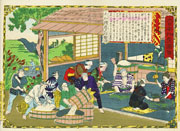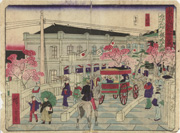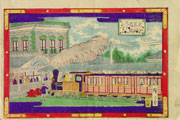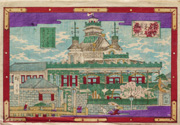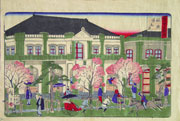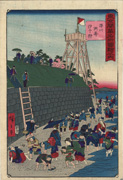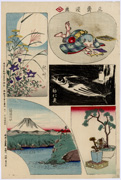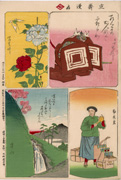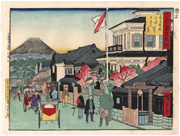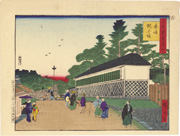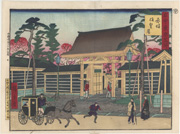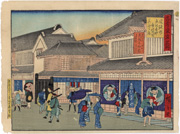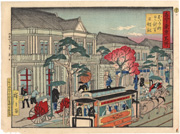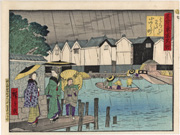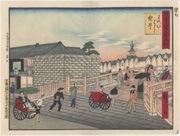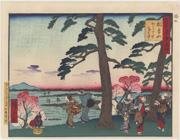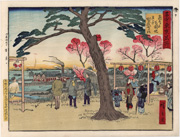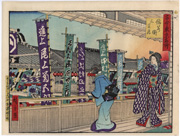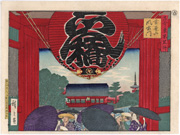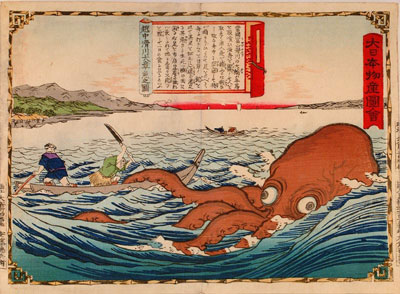Prints in Collection
The series Nihon chishi ryakuzu (Simple Illustrations of Places in Japan), 1876
| Iga Province: Ueno, Nagatagawa IHL Cat. #552 | Kai Province: Monkey Bridge IHL Cat. #585 | Iwami Province: Mount Takazuno Salt Beach IHL Cat. #536 |
Oki Province: Takuhiyama, Takibi no Yashiro
IHL Cat. #1082
The series Dai Nippon Bussan Zue (Products of Greater Japan), 1877
Aki Province
Selling Toothpicks at Itsukushima and Hiroshima Oyster Farm in Aki Province (crepe print)
IHL Cat. #668Bingo Province
Mat Making in Bingo Province
IHL Cat. #461 and
#1921 (crepe print)
Planting Rush in Bingo Province
(crepe print)
IHL Cat. #1920Bizen Province
Slate Pencil Making in Bizen Okayama
IHL Cat. #590
-intentionally left blank-
Chishima Province and Hokkaido
Catching Sea Otter
in Chishima Province
IHL Cat. #1478
Shipping Ice
from Hakodate, Hokkaidō
IHL Cat. #1479Echigo Province
Bleaching Fabric
on the Snow in Echigo Province
IHL Cat. #366 and #1490
Catching Salmon in Echigo Province
IHL Cat. #364 and #1489Etchu Province Iron Works in Etchu Province
IHL Cat. #369
-intentionally left blank-
Hitachi Province
Silkworm Culture in Hitachi Province (figure 1)
IHL Cat. #589
-intentionally left blank-Hizen Province
Manufacturing Imari Porcelain in Hizen [Province], figure 1
IHLCat. #1499
Manufacturing Imari Porcelain, figure 2 in Hizen [Province]
IHL Cat.#1494Hyūga Province
Camphor Manufacture in Hyuga Province
IHL Cat. #542
Producing Vitriol in Hyūga Province
IHL Cat. #325
Iga Province
Polishing-sand of Iga Province
IHL Cat. #323 and #1428
Coal Mining in Iga Province
IHL Cat. #324 and #1486Iki Province
Pulling Up a Whale in Iki Province (crepe print)
IHL Cat. #1918Ise Province
Abalone Divers in Ise Province
IHL Cat. #1482
Making Stretched Dried Abalone in Ise Province
IHL Cat. #1493
Silkworm Culture in Iwaki Province (figure 4)
IHL Cat. #372
Wild Horse Capture in Iwaki Province
IHL Cat. #368
Iyo Province
Capturing Falcons in Iyo Province, figure 1
IHL Cat. #537 and #1508
Crane Hawk [falconry] in Iyo Province figure 2
IHL Cat. #1507Izu Province
Charcoal Making in Izu Province
IHL Cat. #371
Making Camellia Oil in Izu Province
IHL Cat. #365
Kaga Province
Bear Hunting for Gall in Kaga Province
IHL Cat. #272 and #1496
Sedge Hat Making in Kaga Province
IHL Cat. #462 and #1502
-intentionally left blank-Kii Province
Mandarin Orange Plantation in Kii Province
IHL Cat. #540 and
#1919 (crepe print)
-intentionally left blank-
Mikawa Province
Harvesting Lacquer in Mikawa Province
IHL Cat. #539
-intentionally left blank-Noto Province
Making Sōmen in Noto Province
IHL Cat. #1501
Mackerel Fishing at Night in Noto Province
IHL Cat. #363 and #1500Sanuki Province
White Sugar Production in Sanuki Province
IHL Cat. #541
Making Sanbon Sugar in Sanuki Province
IHL Cat. #1470
Settsu Province
Sake Brewing at Itami in Settsu Province (crepe print)
IHL Cat. #1907
Shipping New Brew Sake in Settsu Province (crepe print)
IHL Cat. #1945Shimosa Province
Soy Sauce and Watermelon Field in Shimosa Province
IHL Cat. #362Suruga Province
Manufacturing Bamboo Work in Suruga Province
IHL Cat. #373
Papermaking in
Suruga Province
IHL Cat. #381
Tajima Province
Making Wicker Trunks in Tajima Province
IHL Cat. #1491
Cultivating Wild Silkworms in Tajima Province
IHL Cat. #1497Tango Province
Catching Yellowtails in Tango Province
IHL Cat. #374 and #1498
Beach Fishing for Yellowtail in Tango Province
IHL Cat. #1505Tosa Province
Fishing for Bonito in Tosa Province
IHL Cat. #1492
Making Dried Bonito Flakes in Tosa Province
IHL Cat. #1509
Wakasa Province
Fishing for Flatfish in Wakasa Province
IHL Cat. #1485
Making Steamed Flatfish in Wakasa Province
IHL Cat. #1487Yamashiro Province
Picking Uji Tea in Yamashiro Province, figure 1
IHL Cat. #1495
Producing Uji Tea in Yamashiro Province, figure 2
IHL Cat. #1481Yamato Province
Digging Kudzu [Pueraria] Root in Yamato Province
IHL Cat. #1480
Making Arrowroot Powder in Yamato Province
IHL Cat. #367, #367A, #1506
| Gathering Shellfish at Low Tide at Fukagawa Susaki from the series Famous Views in Modern Tokyo, 1876 IHL Cat. #1169 |
The series Ryūsai manga (Sketches by Ryūsai), 1879
The series Kokon Tokyo meisho (Famous Places of Tokyo: Past and Present), 1883-1884
| -intentionally left blank- IHL Cat. #1284 | IHL Cat. #605 IHL Cat. #1289 | The Ebisuya and Hoteiya Dry-Goods Store in Owari-chō, 1884 [past view] IHL Cat. #1281 IHL Cat. #1282 |
| Yoroi Ferry at Koami-chō [past view] IHL Cat. #1280 Yoroi Bridge at Kabuto-chō [present view] IHL Cat. #1290 | IHL Cat. #1291 IHL Cat. #1285 | Saruwaka-machi sanshibai [past view] IHL Cat. #1283 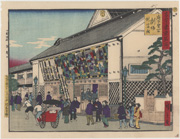 Fukadaiichi no gekijō Shintomi-za [present view] IHL Cat. #1292 |
Kinryūzan Kaminarimon (Thunder Gate, Sensōji in Asakusa) [past view] IHL Cat. #1279 | -intentionally left blank- | -intentionally left blank- |
Picture of the Imperial Palace Buildings, 1888
IHL Cat. #814
Biographical Data
Biography
Utagawa Hiroshige III 三代目 歌川広重 (1842-1894)Sources: The Hotei Encyclopedia of Japanese Woodblock Prints, Amy Reigle Newland, Hotei Publishing Company, 2005, p. 504; Picturing Westernization and Modernization: A Woodblock Print Collection from Late 19th Century Japan,Izumi Koide, June 16, 2006, a paper delivered at the WORLD LIBRARY ANDINFORMATION CONGRESS: 72ND IFLA GENERAL CONFERENCE AND COUNCIL 20-24August 2006, Seoul, Korea http://archive.ifla.org/IV/ifla72/papers/085-Koide-en.pdf and as otherwise footnoted.
Other names used: Gotō Torakichi 後藤 寅吉, Tokubei 徳兵衛, Torakichi 寅吉, Isshōsai 一笑斎, Shigemasa 重政, Shigetora 重寅, Ichiryūsai 一立斎, Ryūsai 立斎
Family name: Andō Tokubei 安藤 徳兵衛 (安藤徳兵エ)
Note: Hiroshige is also written 廣重, as is used in most of the artist's signatures.
The son of a shipbuilder in Edo’s Fukagawa district, later adopted by a restaurant owner named Ryotei, he became a student of Utagawa Hiroshige (1797-1858) in his mid-teens. With his master’s death in 1858 he studied with Utagawa Hiroshige II (1826-1869), who was married to Hiroshige’s daughter, Otatsu. Reportedly his first work was the illustration of the ninth volume of the ehon (picture book) Edo miyage (Picture-book of Edo Souvenirs, 1864). With the dissolution of the Hiroshige II’s marriage and Hiroshige II's subsequent return to Yokohama in 1865, Hiroshige III married Otatsu and succeeded to the Hiroshige name.
While none of the lyricism seen in the work of Hiroshige I is detected in his prints, he created quite interesting prints depicting the new port city of Yokohama and Tokyo with their Western buildings, steam locomotives (such as the triptych Steam Train Along Tokyo’s Takanawa Coastline (Tokyo Takanawa kaigan joki kisha tetsudeo no zu 1871), and exotic foreigners. It is said that the artist referred to himself as "Meiji" Hiroshige.1 He designed many print series, three of the best known being Famous Views of Tokyo (Tokyo meisho no uchi, 1879), Famous Places in Tōkai: The Revised 53 Stations (Tōkai Meisho Kaisei 53 Eki, 1876) and Dai Nippon Bussan Zue (The Greater Japan Products, 1877).
While Hiroshige III may not have been a great artist, he was a popular artist, ranking among the top five in a 1880 list of ukiyo-e artists, Kokoku shoga mekia ichiran, along with Toyohara Kunichika (1835–1900), Ogata Gekkō (1859-1920), Tsukioka Yoshitoshi (1839-1892) and Kobayashi Kiyochika (1847-1915).2
1 The World of the Meiji Print: Impressions of a New Civilization, Julia Meech-Pekarik, Weatherhill, 1986, p. 92.
2 Courage and Silence: A Study of the Life and Color Woodblock Prints of Tsukioka Yoshitoshi: 1839-1892, Roger Keyes, 1982, p. 51.
Among the series of scenic views designed by Hiroshige III are True Views of Tokyo; Famous Places of Tokyo (Tokyo meisho zue); Famous Comic Views of Tokyo; Famous Places of Modern Tokyo (Tokyo kaika meisho zue no uchi); Pictures of the Famous Sights of Tokyo; A Collection of True Views of Tokyo; The Pride of Tokyo Series; Collected Pictures of Tokyo; Photographic Eight Views of Tokyo; The Famous Places of Tokyo-The Past and The Present; Pride of Tokyo: Eight Views of Famous Places (Tokyo jiman meisho hakkei); Thirty-six Views of Tokyo Civilization.
The son of a shipbuilder in Edo’s Fukagawa district, later adopted by a restaurant owner named Ryotei, he became a student of Utagawa Hiroshige (1797-1858) in his mid-teens. With his master’s death in 1858 he studied with Utagawa Hiroshige II (1826-1869), who was married to Hiroshige’s daughter, Otatsu. Reportedly his first work was the illustration of the ninth volume of the ehon (picture book) Edo miyage (Picture-book of Edo Souvenirs, 1864). With the dissolution of the Hiroshige II’s marriage and Hiroshige II's subsequent return to Yokohama in 1865, Hiroshige III married Otatsu and succeeded to the Hiroshige name.
While none of the lyricism seen in the work of Hiroshige I is detected in his prints, he created quite interesting prints depicting the new port city of Yokohama and Tokyo with their Western buildings, steam locomotives (such as the triptych Steam Train Along Tokyo’s Takanawa Coastline (Tokyo Takanawa kaigan joki kisha tetsudeo no zu 1871), and exotic foreigners. It is said that the artist referred to himself as "Meiji" Hiroshige.1 He designed many print series, three of the best known being Famous Views of Tokyo (Tokyo meisho no uchi, 1879), Famous Places in Tōkai: The Revised 53 Stations (Tōkai Meisho Kaisei 53 Eki, 1876) and Dai Nippon Bussan Zue (The Greater Japan Products, 1877).
While Hiroshige III may not have been a great artist, he was a popular artist, ranking among the top five in a 1880 list of ukiyo-e artists, Kokoku shoga mekia ichiran, along with Toyohara Kunichika (1835–1900), Ogata Gekkō (1859-1920), Tsukioka Yoshitoshi (1839-1892) and Kobayashi Kiyochika (1847-1915).2
1 The World of the Meiji Print: Impressions of a New Civilization, Julia Meech-Pekarik, Weatherhill, 1986, p. 92.
2 Courage and Silence: A Study of the Life and Color Woodblock Prints of Tsukioka Yoshitoshi: 1839-1892, Roger Keyes, 1982, p. 51.
Many Views of Tokyo
"Meiji" Hiroshige, as the artist liked to refer to himself, created at least 10 series for various publishers that presented idealized scenic views of Tokyo. The various series quite often presented similar views of the same scenic bridges and districts. As an example see IHL Cat. #484 View of Yanagi Bridge from Asakusa Bridge from the series Famous Places of Tokyo and IHL Cat. #494 Edobashi from the series Tokyo fuka meisho zukushi.Among the series of scenic views designed by Hiroshige III are True Views of Tokyo; Famous Places of Tokyo (Tokyo meisho zue); Famous Comic Views of Tokyo; Famous Places of Modern Tokyo (Tokyo kaika meisho zue no uchi); Pictures of the Famous Sights of Tokyo; A Collection of True Views of Tokyo; The Pride of Tokyo Series; Collected Pictures of Tokyo; Photographic Eight Views of Tokyo; The Famous Places of Tokyo-The Past and The Present; Pride of Tokyo: Eight Views of Famous Places (Tokyo jiman meisho hakkei); Thirty-six Views of Tokyo Civilization.
The Series Dai Nippon Bussan Zue 大日本物産図会 (Products of Greater Japan), 1877
Consisting of 118 chūban-size prints, this series was one of Hiroshige's most popular, issued by the publisher Ōkura Magobei in August 1877 to coincide with the opening of Japan’s first National Industrial Exposition (Naikoku Kangyō Hakurankai) held in Tokyo’s Ueno Park.For detailed information on this series, please see the article on this site titled
Artist's Signatures
There is great similarity between the signatures of Hiroshige, Hiroshige II and Hiroshige III with the most confusion arising between the signatures of Hiroshige II and Hiroshige III. Examples of Hiroshige III's signatures follow. For information on Hiroshige II's signatures, see Utagawa Hiroshige II (1826-1869).
 Hiroshige |  Hiroshige ga |  廣重筆 Hiroshige hitsu |  廣重筆 Hiroshige hitsu |  |  廣重画 ōju Hiroshige ga |  |
Collections
British Museum illustrated book registration number:1973,0723,0.116 (partial set)
Waseda University Library Archives
National Institute of Japanese Literature
Hagi Yamaguchi Prefectural Art Museum
1 In the series two pictures are devoted to each region, or old “kuni,” except the Iyo region, which has four pictures.
last revision:
9/27/2018
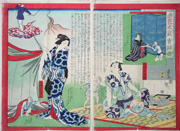
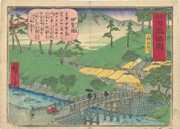

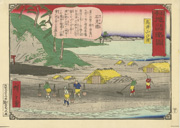
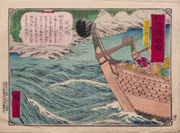
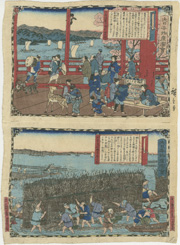
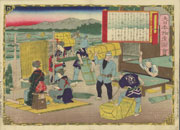
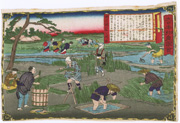
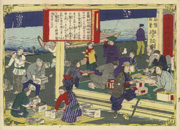
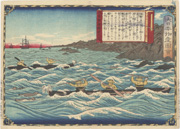
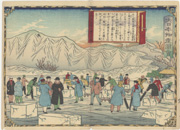
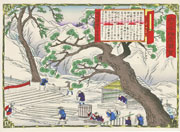
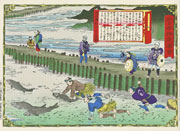
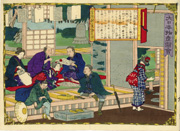
![Manufacturing Imari Porcelain in Hizen [Province], figure 1 from the series Dai Nippon Bussan Zue (Products of Greater Japan)](utagawa-hiroshige-iii-1842-1894/Making Imari pottery figure 1-216715066e4460a2.jpg)
![Manufacturing Imari Porcelain, figure 2 in Hizen [Province] from the series Dai Nippon Bussan Zue (Products of Greater Japan)](utagawa-hiroshige-iii-1842-1894/Making Imari pottery figure 2-442c6bc228d873db.jpg)
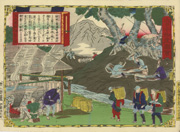

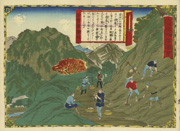
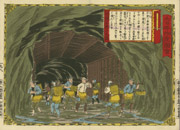
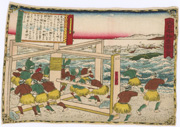
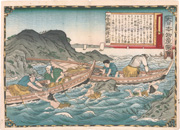
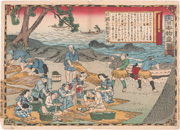
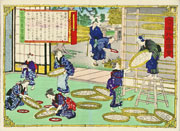
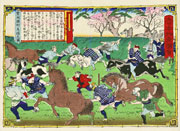
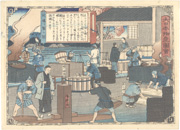
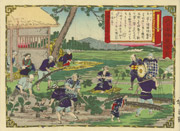
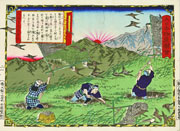
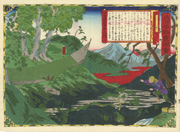
![Crane Hawk [falconry], Figure 2 in Iyo Province Figure 1 from the series Dai Nippon Bussan Zue (Products of Greater Japan)](utagawa-hiroshige-iii-1842-1894/Crane hawk falconry figure 2 -55e0525ffc3c9ebe.jpg)
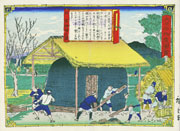
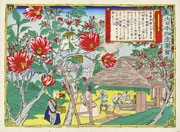
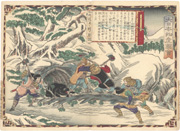

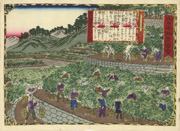
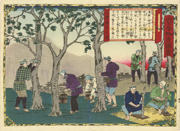
 in -6e25dd3ecc2039af.jpg)
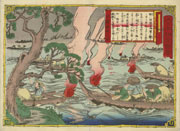
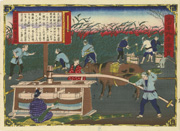
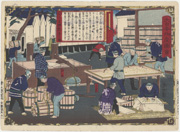
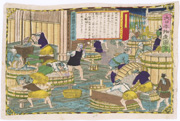
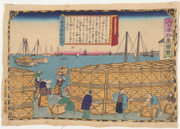
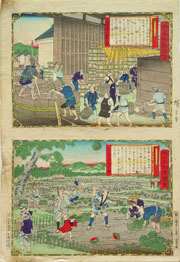
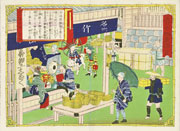

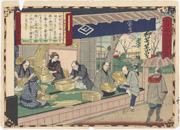
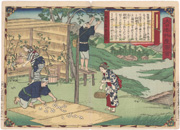
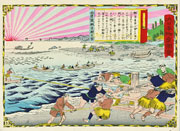
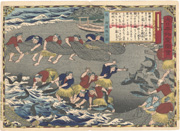
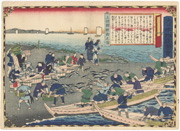
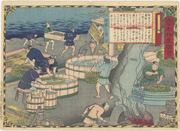
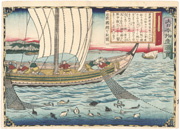
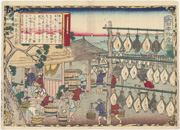
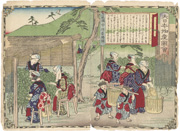
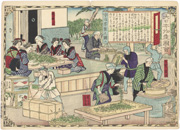
![Digging Kudzu [Pueraria] Root from the series Dai Nippon Bussan Zue (Products of Greater Japan) in Yamato Province](utagawa-hiroshige-iii-1842-1894/Digging pueraria root in Yama-d55172e0607e1d84.jpg)
